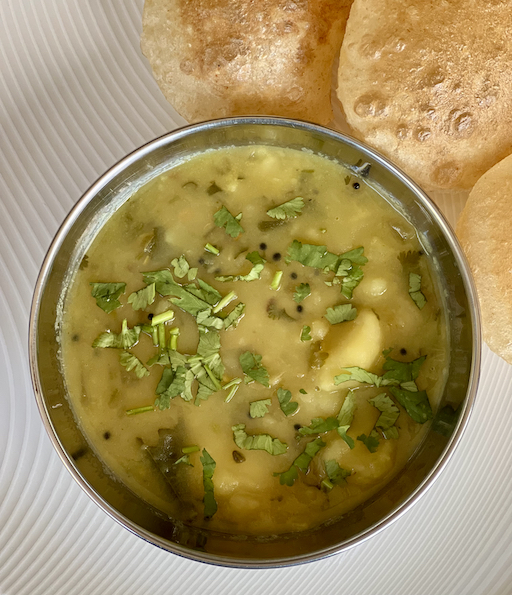This is a gravy style preparation of potatoes and onions traditionally served in Bangalore as a side dish with pooris or idlis. This is a recipe that comes together with a few basic ingredients such as potatoes, onions, green chilis, and fresh ginger in less than 30 minutes. The resulting dish hits all the right notes of spicy, aromatic goodness with the broth that is formed with the potatoes. For a good neer palya, it is essential to use a waxy variety of potatoes, such as yukon gold or white potatoes. In a pinch, you can use russet potatoes, but you will have to be very careful not to overcook the potatoes, or handle them too much.
This was a huge favorite at home growing up in Bangalore, and continues to be so with my family now. Given a choice between sambar (with idlis), or chole (with pooris), we opt for this neer palya every time. This palya is especially tasty with rava idlis and coconut chutney. Poori, neer palya, and my kesar cardamom shrikhand is one of our top 10 favorite dinners.
Potato Neer Palya
Ingredients
- 4 large White or yellow potatoes Use a potato variety that is waxy rather than dry and floury when cooked.
- 1 medium Onion finely diced
- 2 – 3 Green chilis finely chopped. Adjust based on spice level
- 1 inch piece Fresh ginger grated
- 2 Tbsp Cilantro finely chopped
- 8-10 Curry leaves
- 1 tsp Black mustard seeds
- 1 tsp Urad dal
- 1 pinch Turmeric powder
- 2 tbsp Canola or Vegetable oil
- 1/2 tsp Salt to taste
Instructions
Prep potatoes
- Fill a pot with enough water to cook the potatoes. If you have a steamer basket, then fill the bottom inch of the pot with water and place the steamer basket in it. I use the steamer that comes with my small electric rice cooker.
- Wash the potatoes under running water and place them in the steamer, or in the water directly.
- Turn the heat on and cook the potatoes until they are just cooked. This usually takes about 10-15 minutes. They are done when a sharp knife slides through the potatoes smoothly without breaking the potato into two halves.
- Transfer the potatoes to a colander and stop the cooking by running cold water over them. Set aside.
- While the potatoes are cooling, prep the rest of the ingredients.
- Once the potatoes have cooled enough to handle, you can peel them if you prefer. I like to leave the skins on if I am using a variety that has a thin skin. It’s completely up to you.
- Using your palms, or the back of a spatula, gently ‘smash’ each potato a couple times until it falls apart into large chunks. Set aside.
Make vaggarnae
- Make the vaggarnae next. Start by heating the oil in a heavy bottomed skillet.
- When the oil begins to shimmer, add the mustard seeds and cover until the seeds finish popping.
- Then lower the heat and add the urad dal. When the dal turns a golden brown, add the green chilis and curry leaves. The curry leaves will spit when they hit the hot oil.
- Next, add the grated ginger and turmeric powder and give everything a quick stir. Your vaggarnae is now ready.
Make the palya
- Add the chopped onions to the vaggarnae and sauté on a low to medium fire until they turn translucent.
- Add the potatoes to the skillet. Add salt and stir to combine. Be gentle with stirring, you don’t want to mash the potatoes completely.
- Next, add a cup of water to the mixture, stir once gently, and then let the potatoes cook till they form a thin gravy with the water. If the water gets absorbed too quickly, you can add a little more. This should take about 4-5 minutes.
- Taste the palya and adjust the salt if necessary before turning the heat off.
- Garnish with chopped cilantro and serve immediately.
- The palya will thicken as it cools. If this happens, add a few tablespoons of water and heat through before serving.

